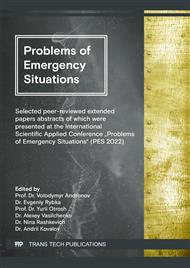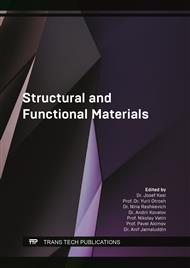[1]
Sadkovyi, V., Rybka, E., Otrosh, Yu. and others (2021). Fire resistance of reinforced concrete and steel structures. PC TECHNOLOGY CENTER, 180.
DOI: 10.15587/978-617-7319-43-5
Google Scholar
[2]
Vambol S., Vambol V., Suchikova Y., Deyneko N. Analysis of the ways to provide ecological safety for the products of nanotechnologies throughout their life cycle. Eastern-European Journal of Enterprise Technologies, 1 10–85 (2017) 27–36.
DOI: 10.15587/1729-4061.2017.85847
Google Scholar
[3]
M.S. Zafar, Prosthodontic Applications of Polymethyl Methacrylate (PMMA): An Update, Polym., 12(10) (2020) 2299.
DOI: 10.3390/polym12102299
Google Scholar
[4]
S. Zolotov, O. Pustovoitova, P. Firsov, Y. Orel, M. Rezunenko, Application of energy efficient materials in reconstruction of buildings and structures of transport infrastructure. IOP Conference Series: Mater. Sci. Eng., 1021 (2021).
DOI: 10.1088/1757-899x/1021/1/012032
Google Scholar
[5]
A. Vasilchenko, Yu. Otrosh, N. Adamenko, E. Doronin, A. Kovalov, Feature of fire resistance calculation of steel structures with intumescent coating. MATEC Web of Conferences, 230 (2018) 02036.
DOI: 10.1051/matecconf/201823002036
Google Scholar
[6]
A. Lovska, O. Fomin, A new fastener to ensure the reliability of a passenger car body on a train ferry. Acta Polytech., 60(6) (2020) 478-485.
DOI: 10.14311/ap.2020.60.0478
Google Scholar
[7]
Y. Otrosh, Y. Rybka, O. Danilin, M. Zhuravskyi, Assessment of the technical state and the possibility of its control for the further safe operation of building structures of mining facilities. E3S Web of Conferences, 123 (2019) 01012.
DOI: 10.1051/e3sconf/201912301012
Google Scholar
[8]
V.I. Slyvynskyi, A.I. Alyamovskyi, A.V. Kondratjev, M.E. Kharchenko, Carbon honeycomb plastic as light-weight and durable structural material, IAC 2012, Naples, 8 (2012) 6519-6529.
Google Scholar
[9]
S. Ugrimov, N. Smetankina, O. Kravchenko, V. Yareshchenko, Analysis of Laminated Composites Subjected to Impact, Springer International Publishing, in Integrated Computer Technologies in Mechanical Engineering - 2020, Cham, 2021, 188 (2021) 234-246.
DOI: 10.1007/978-3-030-66717-7_19
Google Scholar
[10]
A. Kondratiev, O. Prontsevych, Stabilization of physical-mechanical characteristics of honeycomb filler based on the adjustment of technological techniques for its fabrication. East.-Eur. J. Enterp. Techn., 5(1(95)) (2018) 71-77.
DOI: 10.15587/1729-4061.2018.143674
Google Scholar
[11]
M. Thirumala Patil, S.N. Lakshminarasimhan, G. Santhosh, Optical and thermal studies of host Poly (methyl methacrylate) (PMMA) based nanocomposites: A review, Mater. Today: Proceed., 46 (2021) 2564-2571.
DOI: 10.1016/j.matpr.2021.01.840
Google Scholar
[12]
A. Kondratiev, Improving the mass efficiency of a composite launch vehicle head fairing with a sandwich structure. East.-Eur. J. Enterp. Techn., 6(7(102)) (2019) 6-18.
DOI: 10.15587/1729-4061.2019.184551
Google Scholar
[13]
A. Kovalov, Y. Otrosh, E. Rybka, T. Kovalevska, V. Togobytska, I. Rolin, Treatment of Determination Method for Strength Characteristics of Reinforcing Steel by Using Thread Cutting Method after Temperature Influence. In Materials Science Forum, 1006 (2020) 179-184.
DOI: 10.4028/www.scientific.net/msf.1006.179
Google Scholar
[14]
U. Ali, K.J.B.A. Karim, N.A. Buang, A Review of the Properties and Applications of Poly (Methyl Methacrylate) (PMMA), Polym. Reviews, 55(4) (2015) 678-705.
DOI: 10.1080/15583724.2015.1031377
Google Scholar
[15]
I. Dadashov, V. Loboichenko, A. Kireev, Analysis of the ecological characteristics of environment friendly fire fighting chemicals used in extinguishing oil products. Pollution Research, 37 1 (2018) 63–77.
Google Scholar
[16]
V. Sadkovyi, B. Pospelov, V. Andronov, E. Rybka, O. Krainiukov, А. Rud, K. Karpets, Yu. Bezuhla, Construction of a method for detecting arbitrary hazard pollutants in the atmospheric air based on the structural function of the current pollutant concentrations. Eastern-European Journal of Enterprise, 6/10 108 (2020) 14–22.
DOI: 10.15587/1729-4061.2020.218714
Google Scholar
[17]
B. Pospelov, V. Andronov, E. Rybka, M. Samoilov, O. Krainiukov, I. Biryukov, T. Butenko, Yu. Bezuhla, K. Karpets, E. Kochanov, Development of the method of operational forecasting of fire in the premises of objects under real conditions. Eastern-European Journal of Enterprise, 2/10 110 (2021) 43–50.
DOI: 10.15587/1729-4061.2021.226692
Google Scholar
[18]
H.M.C.C. Somarathna, S.N. Raman, D. Mohotti, A.A. Mutalib, K.H. Badri, The use of polyurethane for structural and infrastructural engineering applications: A state-of-the-art review, Constr. Build. Mater., 190 (2018) 995-1014.
DOI: 10.1016/j.conbuildmat.2018.09.166
Google Scholar
[19]
V. Kombarov, Y. Kryzhyvets, I. Biletskyi, Y. Tsegelnyk, Y. Aksonov, L. Piddubna, Numerical Control of Fiberglass Pipe Bends Manufacturing, 2021 IEEE 2nd KhPI Week on Advanced Technology (KhPIWeek), (2021) 357-362.
DOI: 10.1109/khpiweek53812.2021.9570068
Google Scholar
[20]
A. Kondratiev, V. Gaidachuk, T. Nabokina, V. Kovalenko, Determination of the influence of deflections in the thickness of a composite material on its physical and mechanical properties with a local damage to its wholeness. Eas.-Eur. J. Enterp. Techn., 4(1(100)) (2019) 6-13.
DOI: 10.15587/1729-4061.2019.174025
Google Scholar
[21]
Y.M. Zhu, W.W. Liang, X.L. Zhao, X.R. Wang, J. Xia, Strength and stability of spherical pressure hulls with different viewport structures, Int. J. Pressure Vessels Piping, 176 (2019) 103951.
DOI: 10.1016/j.ijpvp.2019.103951
Google Scholar
[22]
W. Cui, F. Wang, B. Pan, Y. Hu, Q. Du, Issues to be solved in the design, manufacture and maintenance of a full ocean depth manned cabin, Adv. Eng. Res., 11 (2015) 1-29.
Google Scholar
[23]
B. Kemper, L. Cross, Heat Retention and Structural Integrity of Glassy Polym. Viewports. (2018).
Google Scholar
[24]
N. Gasratova, V. Zuev, On the design of deep-sea optical elements made of PMMA, IOP Conference Series: Mater. Sci. Eng., 734 (2020) 012069.
DOI: 10.1088/1757-899x/734/1/012069
Google Scholar
[25]
N. Gasratova, V. Zuev, M.M. Trukhin, Concerning the Determination of the Geometrical Parameters of the Optical Element of a Deep-Water Surveillance System, Int. J. Eng. Techn. (UAE), 7 (2018) 957-961.
Google Scholar
[26]
T. Trudel, K. Stanley, Window Seat Weight Reduction Exploration With Nontraditional Seat Geometry, Marine Techn. Soc. J., 53(1), (2019) 107-116.
DOI: 10.4031/mtsj.53.1.2
Google Scholar
[27]
V.R. Sastri, 6 – Engineering Thermoplastics: Acrylics, Polycarbonates, Polyurethanes, Polyacetals, Polyesters, and Polyamides, in Plastics in Medical Devices (Third Edition), V. R. Sastri Ed.: William Andrew Publishing, 2022, pp.167-232.
DOI: 10.1016/b978-0-323-85126-8.00011-4
Google Scholar
[28]
A. Kondratiev, V. Píštěk, S. Purhina, M. Shevtsova, A. Fomina, P. Kučera, Self-Heating Mould for Composite Manufacturing, Polym., 13(18) (2021) 3074.
DOI: 10.3390/polym13183074
Google Scholar
[29]
B. Liu, L. Zhao, A.J.M. Ferreira, Y.F. Xing, A.M.A. Neves, J.Y. Wang, Analysis of viscoelastic sandwich laminates using a unified formulation and a differential quadrature hierarchical finite element method, Compos. Part B-Eng., 110 (2017) 185-192.
DOI: 10.1016/j.compositesb.2016.11.028
Google Scholar
[30]
P.F. Liu, S.B. Wang, X.K. Li, Finite Element Analysis of Failure Behaviors of the Inspection Window of the Deep-Sea Submersible, J. Fail. Anal. Prev., 18(5) (2018) 1198-1209.
DOI: 10.1007/s11668-018-0508-3
Google Scholar
[31]
B. Kemper, Use of Finite Element Analysis in Designing Acrylic Structures for Fatigue and Stress. (2016).
Google Scholar
[32]
Q.H. Du, Y. Hu, W.C. Cui, Safety assessment of the acrylic conical frustum viewport structure for a deep-sea manned submersible, Ships Offsh. Struct., 12 (2017) S221-S229.
DOI: 10.1080/17445302.2016.1261390
Google Scholar
[33]
O.Z. Dveirin, O.V. Andreev, A.V. Kondrat'ev, V.Y. Haidachuk, Stressed State in the Vicinity of a Hole in Mechanical Joint of Composite Parts, Int. Appl. Mechan., 57(2) (2021) 234-247.
DOI: 10.1007/s10778-021-01076-4
Google Scholar
[34]
A. Kovalov, Yu. Otrosh, M. Surianinov, T. Kovalevska, Experimental and computer researches of ferroconcrete floor slabs at high-temperature influences, Materials Science Forum, 968 (2019) 361–367.
DOI: 10.4028/www.scientific.net/msf.968.361
Google Scholar
[35]
Yu. Otrosh, M. Surianinov, O. Holodnov, O. Starova, Experimental and computer researches of ferroconcrete beams at high-temperature influences, Materials Science Forum, 968 (2019) 355–360.
DOI: 10.4028/www.scientific.net/msf.968.355
Google Scholar
[36]
T. Ishida, R. Kitagaki, S. Yamane, H. Hagihara, Temperature dependence of structural alteration by ultraviolet irradiation in acrylic-urethane coatings studied by positron annihilation spectroscopy and solvent swelling behavior, Polym. Degrad. Stabil., 162 (2019) 85-93.
DOI: 10.1016/j.polymdegradstab.2019.02.007
Google Scholar
[37]
A.I. Kovalov, Y.A. Otrosh, S. Vedula, O.M. Danilin, T.M. Kovalevska, Parameters of fire-retardant coatings of steel constructions under the influence of climatic factors, Nauk. Visnyk Nats. Hirnych. Univ., (3) (2019) 46-53.
DOI: 10.29202/nvngu/2019-3/9
Google Scholar
[38]
T. Ishida, R. Kitagaki, H. Hagihara, Y. Elakneswaran, Challenges in prediction of significant structural changes during photochemical degelation, of acrylic-urethane network, Polym., 186, (2020) 122035.
DOI: 10.1016/j.polymer.2019.122035
Google Scholar
[39]
Y. Danchenko, V. Andronov, M. Teslenko, V. Permiakov, E. Rybka, R. Meleshchenko, A. Kosse, Study of the free surface energy of epoxy composites using an automated measurement system. Eastern-European Journal of Enterprise Technologies, 1 12–91 (2018) 9–17.
DOI: 10.15587/1729-4061.2018.120998
Google Scholar
[40]
J.D. Stachiw, M.T. Society, Handbook of Acrylics for Submersibles, Hyperbaric Chambers, and Aquaria. Best Publishing Company, (2003).
Google Scholar
[41]
T. Ishida, E. Richaud, M. Gervais, A. Gaudy, R. Kitagaki, H. Hagihara, Y. Elakneswaran, Thermal aging of acrylic-urethane network: Kinetic modeling and end-of-life criteria combined with mechanical properties, Progr. Organic Coatings, 163 (2022) 106654.
DOI: 10.1016/j.porgcoat.2021.106654
Google Scholar
[42]
S.B. Pranesh, D. Kumar, V.A. Subramanian, D. Sathianarayanan, G.A. Ramadass, Structural analysis of spherical pressure hull viewport for manned submersibles using biological growth method, Ships Offsh. Struct., 13(6) (2018) 601-616.
DOI: 10.1080/17445302.2018.1440885
Google Scholar
[43]
F. Wang, W. Wang, Y. Zhang, Q. Du, Z. Jiang, W. Cui, Effect of Temperature and Nonlinearity of PMMA Material in the Design of Observation Windows for a Full Ocean Depth Manned Submersible, Marine Techn. Soc. J., 53(1) (2019) 27-36.
DOI: 10.4031/mtsj.53.1.4
Google Scholar
[44]
Y. Burdun, V. Kochanov, T. Yuresko, Prediction of the service life of deep-sea conical acrylic portholes at designing, East.-Eur. J. Enterp. Techn., 1(1(103)) (2020) 40-46.
DOI: 10.15587/1729-4061.2020.194584
Google Scholar



